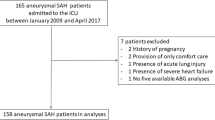Abstract
Introduction: Aneurysmal subarachnoid hemorrhage (SAH) affects 30,000 patients per year, causing neurologic morbidity and mortality. The etiology of hypoxemia and its role in comorbidity are controversial and unknown.
Purpose: To identify the incidence and etiologies of oxygenation abnormalities following SAH and to determine its impact on length of hospital stay (LOS).
Methods: We retrospectively reviewed 70 consecutive SAH patients’ records, including review of computed tomography scans, chest X-rays, arterial blood gases, electrocardiograms, echocardiograms, blood pressure, carbon monoxide, central venous pressure, and pulmonary capillary wedge pressure. Fluid balance and chest X-ray interpretation on admission and at time of worst alveolar-arterial oxygen difference was assessed, as was length of hospital stay.
Results: Fifty six (80%) patients had impaired oxygenation (alveolar-arterial oxygen difference >100 mmHg). Of these 56, 50% had normal chest X-rays. Patients were euvolemic and normodynamic with mean central venous pressure 8.8±4.1 mmHg and had normal cardiac output 6.8±2.4 L/min. The most frequent etiologies of hypoxemia based on composite data assessment were pneumonia 8/56 (14%), fulminant neurogenic pulmonary edema 9/56 (16%), atelectasis 5/56 (27%), and cryptogenic (57%). The mean length of stay was doubled in the impaired oxygenation group 19.3 days±14.6 compared with 7.1±4.3 days in the normal oxygenation group (p<0.001; df=36). Likewise, the patients with fulminant neurogenic pulmonary edema had a prolonged length of stay of 13.4±6.2 (p<0.002; df=27) compared with the normal oxygenation group. Neither the occurrence of vasospasm nor delayed neurologic deficit influenced the incidence of poor oxygenation (p<0.93).
Conclusion: Oxygenation abnormalities after SAH occur more frequently than previously suspected. They are frequently the result of noncardiogenic and hydrostatic causes and contribute to an increased length of hospital stay.
Similar content being viewed by others
References
Cruickshank JM, Neil-Dwyer G, Stott W. Possible role of catecholamines, corticosteroids and potassium in production of ECG changes associated with subarachnoid hemorrhage. Br Heart J 1974;36:697–706.
Mayer SA, LiMandri G, Sherman D, Lennihan L, Fink ME, Solomon RA, et al. Electrocardiographic markers of abnormal left ventricular wall motion in acute subarachnoid hemorrhage. J Neurosurg 1995;83:889–896.
Jacob WA, Van Bogaert A, DeGroot-Lasseel MHA. Myocardial ultrastructural and hemodynamic reactions during experimental subarachnoid hemorrhage. J Mol Cell Cardiol 1972;4:287–298.
Shanlin RJ, Sole MJ, Rahimifar M, Tator CH, Factor SM. Increased intracranial pressure elicits hypertension, increased sympathetic activity, electrocardiographic abnormalities and myocardial damage in rats. J Am Coll Cardiol 1988;12:727–736.
Samuels MA. Neurogenic heart disease: a unfying hypothesis. Am Coll Cardiol 1987;60:15J-19J.
Diringer MN, Wu K, Verbalis JG, Hanley DF. Hypervolemic therapy prevents volume contraction but not hyponatremia following subarachnoid hemorrhage. Ann Neurol 1992;31:543–550.
Rosenfeld JV, Barnett GH, Sil, CA. The effect of subarachnoid hemorrhage on blood and CSF atrial natriuretic factor. J Neurosurg 1989;71:32–37.
Solenski NJ, Haley EC, Kassell NF, Kongable G, Germanson T, Truskowski L, et. al. Medical complications of aneurysmal subarachnoid hemorrhage: a report of the multicenter, cooperative aneurysm study. Crit Care Med 1995;23:1007–1017.
Weir BK. Pulmonary edema following fatal aneurysmal rupture. J Neurosurg 1978;49:502–507.
Touho H, Karasawa J, Shishido H, Yamada K, Yamazaki Y. Neurogenic pulmonary edema in the acute stage of hemorrhagic cerebrovascular disease. Neurosurgery 1989;25:762–768.
Bleck TP, Vespa P, Brock DG. Oxygenation abnormalities in acute aneurysmal subarachnoid hemorrhage patients. Neurology 1993:43(Suppl 1):A324.
Cole RB, Bishop JM. Effect of varying inspired oxygen tension on alveolar-arterial oxygen tension difference in man. J Appl Physiol 1963;19:1043–1048.
Garner JS, Jarvis WR, Emorl TG, et al. CDC definitions for nosocomial infections. Am J Infect Control 1988;16:128–140.
Fein A, Grossman RF, Jones JG. The value of edema fluid protein measurement in patients with pulmonary edema. Am J Med 1979;67:32–38.
Smith WS, Matthay MA. Evidence for a hydrostatic mechanism in human neurogenic pulmonary edema. Chest 1997;111:1326–1333.
Darragh TM, Simon RP. Nucleus tractus solitarius lesions elevate pulmonary arterial pressure and lymph flow. Ann Neurol 1985;17:565–569.
Schraufnagel DE, Patel KR. Sphincters in pulmonary veins: an anatomic study in rats. Am Rev Resp Dis 1990;141:721–726.
Pistolesi M, Mimiati M, Milne ER, Giuntini C. The chest roentgenogram in pulmonary edema. Clin Chest Med 1985;6:315–343.
Luepker RV, Caralis DG, Voigt GC, Burns RF, Murphy LW, Warbasse JR. Detection of pulmonary edema in acute myocardial infarction. Am Coll Cardiol 1977;39:146–152.
Mayer SA, Fink ME, Homma S, Sherman D, LiMandri G, Lennihan L, et al. Cardiac injury associated with neurogenic pulmonary edema following subarachnoid hemorrhage. Neurology 1994;44:815–820.
Knudsen F, Jensen HP, Petersen PL. Neurogenic pulmonary edema: treatment with dobutamine. Neurosurgery 1991;29:269–270.
Deehan SC, Grant IS. Haemodynamic changes in neurogenic pulmonary oedema: effect of dobutamine. Intensive Care Med 1996;22:672–676.
Locke CF, Sing RF, Sing RF. Neurogenic pulmonary edema. J Am Osteopath Assoc 1993;9:382–384.
Barnes PJ, Baraniuk JN, Belvisi MG. Neuropetides in the respiratory tract. Am Rev Resp Dis 1991;144:1391–1399.
O-Yurvati AH, Laub GW, Sanders SP, Dullye LJ, Reibman JB, McGrath LB. Reduction in pulmonary microvascular pressure following cardiopulmonary bypass: beneficial effects of dobutamine. Int Surg 1995;80:231–234.
Schraufnagel DE, Thakkar MB. Pulmonary venous sphincter constriction is attenuated by alpha-adrenergic antagonism. Am Rev Resp Dis 1993;148:477–482.
Miller JA, Dacey RG Jr, Diringer MN. Safety of hypertensive hypervolemic therapy with phenylephrine in the treatment of delayed ischemic deficits after subarachnoid hemorrhage. Stroke 1995;26:2260–2266.
Ducker TB. Increased intracranial pressure and pulmonary edema. Part 1: clinical study of 11 patients. J Neurosurg 1968;28:112–117.
West JB, Mathieu-Costello O. Stress failure of pulmonary capillaries in the intensive care unit setting. Schweiz Med Wschr 1992;122:751–757.
Friedman JA, Pichelmann MA, Piepgras DG, McIver JI, Toussaint LG 3rd, McClelland RL, et al. Pulmonary complications of aneurysmal subarachnoid hemorrhage. Neurosurgery 2003;52:1025–1031.
Author information
Authors and Affiliations
Corresponding author
Rights and permissions
About this article
Cite this article
Vespa, P.M., Bleck, T.P. Neurogenic pulmonary edema and other mechanisms of impaired oxygenation after aneurysmal subarachnoid hemorrhage. Neurocrit Care 1, 157–170 (2004). https://doi.org/10.1385/NCC:1:2:157
Issue Date:
DOI: https://doi.org/10.1385/NCC:1:2:157




